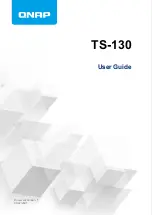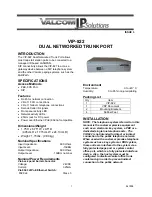
Chapter 14: Basic Administration Protocols
Ethernet Ring Protection Switching
– 452 –
•
Revertive
– Sets the method of recovery to Idle State through
revertive or non-revertive mode. (Default: Enabled)
•
Revertive behavior allows the switch to automatically return the RPL
from Protection state to Idle state through the exchange of protocol
messages.
Non-revertive behavior for Protection, Forced Switch (FS), and
Manual Switch (MS) states are basically the same. Non-revertive
behavior requires the RPL to be restored from Protection state to
Idle state using the Clear command (Configure Operation page).
•
Recovery for Protection Switching – A ring node that has one or
more ring ports in an SF (Signal Fail) condition, upon detecting the
SF condition cleared, keeps at least one of its ring ports blocked for
the traffic channel and for the R-APS channel, until the RPL is
blocked as a result of ring protection reversion, or until there is
another higher priority request (e.g., an SF condition) in the ring.
A ring node that has one ring port in an SF condition and detects
the SF condition cleared, continuously transmits the R-APS (NR – no
request) message with its own Node ID as the priority information
over both ring ports, informing that no request is present at this
ring node and initiates a guard timer. When another recovered ring
node (or nodes) holding the link block receives this message, it
compares the Node ID information with its own Node ID. If the
received R-APS (NR) message has the higher priority, this ring node
unblocks its ring ports. Otherwise, the block remains unchanged. As
a result, there is only one link with one end blocked.
The ring nodes stop transmitting R-APS (NR) messages when they
accept an R-APS (NR, RB – RPL Blocked), or when another higher
priority request is received.
•
Recovery with Revertive Mode – When all ring links and ring
nodes have recovered and no external requests are active,
reversion is handled in the following way:
a.
The reception of an R-APS (NR) message causes the RPL Owner
Node to start the WTR (Wait-to-Restore) timer.
b.
The WTR timer is cancelled if during the WTR period a higher
priority request than NR is accepted by the RPL Owner Node or is
declared locally at the RPL Owner Node.
c.
When the WTR timer expires, without the presence of any other
higher priority request, the RPL Owner Node initiates reversion by
blocking its traffic channel over the RPL, transmitting an R-APS (NR,
RB) message over both ring ports, informing the ring that the RPL is
blocked, and performing a flush FDB action.
d.
The acceptance of the R-APS (NR, RB) message causes all ring
nodes to unblock any blocked non-RPL link that does not have an SF
condition. If it is an R-APS (NR, RB) message without a DNF (do not
flush) indication, all ring nodes flush the FDB.
Summary of Contents for SSE-G2252
Page 42: ...44 General IP Routing on page 627...
Page 603: ...Chapter 16 IP Configuration Setting the Switch s IP Address IP Version 6 609...
Page 883: ...Chapter 24 General Security Measures Port based Traffic Segmentation 894...
Page 989: ...Chapter 30 Congestion Control Commands Automatic Traffic Control Commands 1000 Console...
Page 1007: ...Chapter 33 Address Table Commands 1019...
Page 1137: ...Chapter 38 Quality of Service Commands 1150...
















































